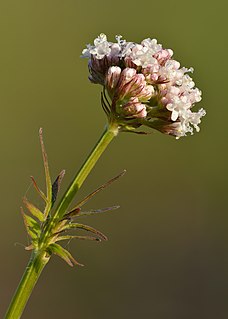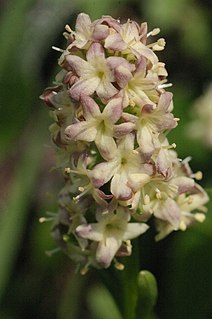
Valerian is a perennial flowering plant native to Europe and Asia. In the summer when the mature plant may have a height of 1.5 metres, it bears sweetly scented pink or white flowers that attract many fly species, especially hoverflies of the genus Eristalis. It is consumed as food by the larvae of some Lepidoptera species, including the grey pug.

Valeriana is a genus of flowering plants in the family Caprifoliaceae, members of which may by commonly known as valerians. It contains many species, including the garden valerian, Valeriana officinalis. Some species are native to Europe, others to North America and South America.

Gynura is a genus of flowering plants in the daisy family Asteraceae endemic to Asia. The best known species is Gynura aurantiaca, often grown as a house plant. This plant is commonly known as "purple passion" because of the velvety purple leaves.
Vachellia cernua is a species of legume in the family Fabaceae. It is found only in Somalia, and is threatened by habitat loss.
Setaria cernua is a species of grass. It is endemic to Ecuador, where it occurs in Imbabura, Carchi and Chimborazo Provinces. Some populations are protected in the Parque Nacional Llanganates, the Parque Nacional Sangay, and the Reserva Ecológica Cayambe-Coca. While its range is limited, it is common there.

Gymnocephalus is a genus of ray-finned fishes from the family Percidae, which includes the perches, pike-perches and darters. They are from the Western Palearctic area, although one species, Gymnocephalus cernua has been accidentally introduced to the Great Lakes region where it is regarded as an invasive species. They have the common name "ruffe" and resemble the true perches in the genus Perca, but are usually smaller and have a different pattern.
Gentianella cernua is a species of plant in the family Gentianaceae. It is endemic to Ecuador. Its natural habitat is subtropical or tropical high-altitude grassland.
Tillandsia cernua is a species of plant in the family Bromeliaceae. It is endemic to Ecuador. Its natural habitats are subtropical or tropical moist montane forests and subtropical or tropical high-altitude shrubland. It is threatened by habitat loss.
Valeriana alypifolia is a species of plant in the family Caprifoliaceae. It is endemic to Ecuador. Its natural habitat is subtropical or tropical high-altitude grassland.
Valeriana aretioides is a species of plant in the family Valerianaceae. It is endemic to Ecuador. Its natural habitat is subtropical or tropical high-altitude grassland.
Valeriana asterothrix is a species of plant in the family Caprifoliaceae. It is endemic to Ecuador. Its natural habitats are subtropical or tropical moist montane forests and subtropical or tropical high-altitude shrubland.
Valeriana buxifolia is a species of plant in the family Caprifoliaceae. It is endemic to Ecuador. Its natural habitats are subtropical or tropical high-altitude shrubland and subtropical or tropical high-altitude grassland.
Valeriana coleophylla is a species of plant in the family Caprifoliaceae. It is endemic to Ecuador. Its natural habitats are subtropical or tropical moist montane forests and subtropical or tropical high-altitude shrubland.
Valeriana secunda is a species of plant in the family Caprifoliaceae. It is endemic to Ecuador. Its natural habitat is subtropical or tropical high-altitude grassland.
'Valeriana extincta' formerly known as Valerianella affinis was a species of plant in the family Caprifoliaceae. It was endemic to Socotra Yemen. It was only found once in Jebel Maaleh near Qalansiyah in 1880 and has not been seen again despite repeated searches in the region.

Isolepis cernua is a species of flowering plant in the sedge family known by the common names low bulrush, slender club-rush, tufted clubrush, and fiberoptic grass. It is widespread, being native to many regions of the world, including parts of Australasia, Eurasia, Africa, and North and South America.

Palhinhaea cernua, synonym Lycopodiella cernua, is a plant in the family Lycopodiaceae, commonly known as the staghorn clubmoss. The Hawaiian name for the plant is wāwaeʻiole, or "rat's foot". It has a substantial number of scientific synonyms in several genera. The genus Palhinhaea is accepted in the Pteridophyte Phylogeny Group classification of 2016, but not in other classifications which submerge the genus in Lycopodiella.

Valeriana celtica is a species of plant in the family Caprifoliaceae. It is also known as Alpine valerian and valerian spikenard. It is endemic to the Eastern Alps and to the Graian and Pennine Alps. It grows as a perennial herb 5 to 15 cm (2.0–5.9 in) tall. Along with Valeriana saxatilis and Valeriana elongata, it forms a clade of dioecious plants. Until the 1930s, it was extensively harvested for export to Asia for use in perfumes. The root has been used as a folk remedy as a nerve tonic.

Yucca cernua E.L. Keith, common name "nodding Yucca," is a rare species in the family Asparagaceae known only from a small region in Newton and Jasper Counties in eastern Texas.
Hopea cernua is a tree in the family Dipterocarpaceae. The specific epithet cernua means "slightly drooping", referring to the flowers.








